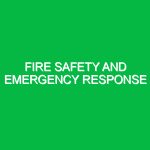Introduction
Load securing and transport is a critical aspect of the logistics and transportation industry, directly influencing safety, efficiency, and environmental impact. At its core, load securing involves the methods and techniques used to stabilize cargo during transit, ensuring it remains safe from shifting or falling. The relevance of this practice within the Health, Safety, and Environment (HSE) domain cannot be overstated; improperly secured loads can lead to accidents, injuries, and significant financial losses for businesses.
Imagine a scenario: a truck carrying heavy machinery is navigating a winding road. If the load is not properly secured, a sudden turn could cause the cargo to shift dangerously, risking not only the truck driver’s life but also those of others on the road. Such incidents highlight the importance of robust load securing practices and compliance with HSE protocols. This article delves into the potential hazards associated with load securing and transport, outlines best practices for safety, and reviews relevant regulations and standards.
Potential Hazards and Risks Associated with Load Securing and Transport
Understanding the potential hazards associated with load securing and transport is the first step in mitigating risks. Several factors contribute to unsafe load conditions:
1. Load Shifting
Load shifting occurs when cargo moves during transport due to inadequate securing methods. This can lead to loss of control over the vehicle, resulting in accidents. For instance, a truck carrying pallets of goods could experience a shift if the pallets are not properly strapped down, leading to a dangerous situation.
2. Overloading
Overloading a vehicle can significantly affect its handling and braking capabilities. Exceeding weight limits not only puts the driver at risk but can also lead to vehicle damage or even road accidents. For example, a delivery truck overloaded with boxes may struggle to stop quickly, increasing the likelihood of collisions.
3. Environmental Factors
Weather conditions such as rain, snow, or high winds can dramatically affect load stability. A sudden gust of wind can cause a tarp to flap and displace cargo, while wet surfaces can reduce traction, increasing the risk of accidents. Proper load securing techniques must account for these factors to ensure safety.
4. Inadequate Training
Employees who lack proper training in load securing techniques are a significant risk factor. An inexperienced individual may not know how to assess the weight distribution or the appropriate securing methods for different types of cargo. This can lead to unsafe practices that compromise transportation safety.
5. Equipment Failure
The failure of securing equipment such as straps, chains, or tarps can result in serious accidents. Regular maintenance and inspection of securing devices are essential to ensure they function correctly. For instance, a worn-out strap could snap under pressure, allowing the cargo to shift unexpectedly.
Safety Precautions and Best Practices
To mitigate the risks associated with load securing and transport, it is vital to implement safety precautions and best practices. Here are some actionable strategies:
1. Conduct Thorough Load Assessments
Before securing any cargo, conduct a detailed assessment of the load. Evaluate its weight, dimensions, and center of gravity. This information will guide you in selecting the appropriate securing methods. For example, heavier items should be placed at the bottom of the load to lower the center of gravity, enhancing stability.
2. Utilize the Right Securing Equipment
Choose the appropriate securing equipment based on the load type and weight. Common tools include straps, chains, and nets. For instance, ratchet straps are ideal for securing lighter loads, while heavier items may require high-quality chains. Always ensure that the equipment used is rated for the weight of the cargo.
3. Follow Load Distribution Guidelines
Proper weight distribution is crucial for vehicle stability. Distribute the load evenly across the vehicle. Avoid placing too much weight on one side, as this can lead to tipping. Many trucking companies implement a “load plan” to visualize and strategize the best weight distribution.
4. Regularly Inspect Securing Equipment
Routine inspections of securing devices can prevent equipment failure. Check for fraying, wear and tear, or corrosion. For example, using a strap with frayed edges could lead to failure during transit. Implementing a regular maintenance schedule can help identify issues before they become critical.
5. Train Employees on Load Securing Techniques
Invest in training programs for employees involved in loading and securing cargo. Equip them with knowledge about best practices, equipment usage, and safety protocols. A well-trained team can significantly reduce the risk of accidents. Consider incorporating real-life case studies to illustrate the importance of proper load securing.
6. Use Weather-Appropriate Securing Measures
Adjust securing methods based on weather conditions. In inclement weather, additional securing measures may be necessary. For instance, in windy conditions, using heavier tarps and tighter straps can help stabilize the load. Similarly, in rainy conditions, ensuring that cargo is waterproofed can prevent damage and maintain load integrity.
Regulations and Standards Governing Load Securing and Transport
Compliance with regulations and standards is paramount in load securing and transport. Various organizations and governmental bodies have established guidelines to ensure safety:
1. Federal Motor Carrier Safety Administration (FMCSA)
In the United States, the FMCSA outlines regulations for securing cargo on commercial vehicles. Their guidelines specify the required securing devices and techniques based on the type and weight of the load.
2. International Organization for Standardization (ISO)
The ISO provides international standards for load securing, promoting safety and consistency across borders. ISO 3874 offers guidelines for the securement of cargo on road vehicles, emphasizing the importance of proper load management.
3. Occupational Safety and Health Administration (OSHA)
OSHA regulations require that employers provide a safe working environment, which includes proper training in load securing practices. Compliance with OSHA standards can help prevent workplace accidents, ensuring employee safety.
4. The National Association of Small Trucking Companies (NASTC)
NASTC offers resources and training materials aimed at improving load securing practices among small trucking companies. Their guidelines emphasize the importance of adhering to HSE standards.
Conclusion
Load securing and transport play a vital role in the HSE domain, impacting the safety of not only drivers but also the general public. By understanding the potential hazards, implementing safety precautions, and complying with regulations, businesses can mitigate risks and enhance operational efficiency.
As the logistics landscape continues to evolve, it is essential for organizations to prioritize load securing practices. Investing in training, equipment, and regular maintenance can lead to safer transport operations, ultimately benefiting everyone involved. As someone who has witnessed the consequences of inadequate load securing firsthand, I can attest to the importance of these practices in preventing accidents and ensuring a safer transportation environment.


